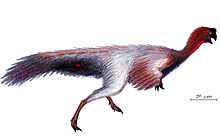Jiangxisaurus
|
Jiangxisaurus Temporal range: Late Cretaceous, 72–66 Ma |
|
|---|---|
 |
|
| Jiangxisaurus | |
| Scientific classification | |
| Kingdom: | Animalia |
| Phylum: | Chordata |
| Class: | Reptilia |
| Clade: | Dinosauria |
| Order: | Saurischia |
| Suborder: | Theropoda |
| Family: | †Oviraptoridae |
| Genus: |
†Jiangxisaurus Wei et al.,2013 |
| Species: | †J. ganzhouensis |
| Binomial name | |
|
Jiangxisaurus ganzhouensis Wei et al.,2013 |
|
Jiangxisaurus is an extinct genus of oviraptorid theropod dinosaur from Late Cretaceous of China. It was similar to Heyuannia, but with more strongly curved anterior claws and a thinner, frailer mandible. This find is paleontologically significant because it contributes to current knowledge about the paleogeographical distribution of oviraptorids in southern China.
The genus name Jiangxisaurus, refers to the Jiangxi Province of southern China. The specific name ganzhouensis, is derived from Gangzhou, the locality where the specimen was discovered. Jiangxisaurus was described and named by Xuefang Wei, Hanyong Pu, Li Xu, Di Liu, and Junchang Lu in 2013 and the type species is Jiangxisaurus ganzhouensis.
The holotype specimen HGM41-HIII0421 consists of an incomplete skull, a lower jaw, eight cervical vertebrae, three dorsal vertebrae, nine caudal vertebrae, a nearly complete pectoral girdle, two chevrons, the left forelimb, both sternal plates, four sternal ribs, nine dorsal ribs, and a partially preserved pelvic girdle. The skull is 150mm long and appears to be a sub-adult. The mandible of Jiangxisaurus is toothless and has a height-to-length ratio of about 20%. The radius is 96mm in length and is 30% shorter than the length of the humerus (136mm). The manus is tridactyl, meaning that it has three fingers – the first digit is robust, the second is elongated and the third digit is slender.
Jiangxisaurus was assigned to the taxon oviraptoridae. This genus shares several traits with other oviraptorids, including a short narrow skull with a toothless jaw, and anterior cerivcal vertebrae that bear pleurocoels. In contrast to its nearest relatives, Jiangxisaurus has an elongated mandible and a less pronounced down-turned rostrum on its lower jaw.
A diagnosis is a statement of the anatomical features of an organism (or group) that collectively distinguish it from all other organisms. Some, but not all, of the features in a diagnosis are also autapomorphies. An autapomorphy is a distinctive anatomical feature that is unique to a given organism.
...
Wikipedia
